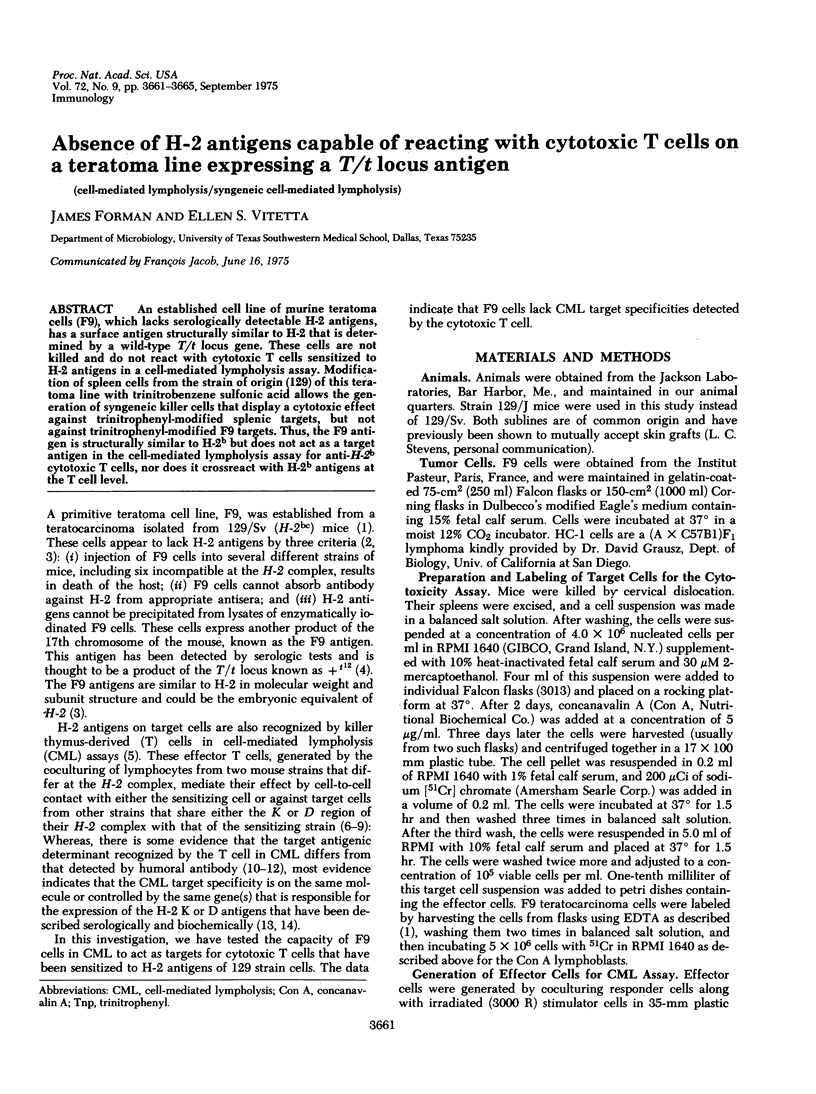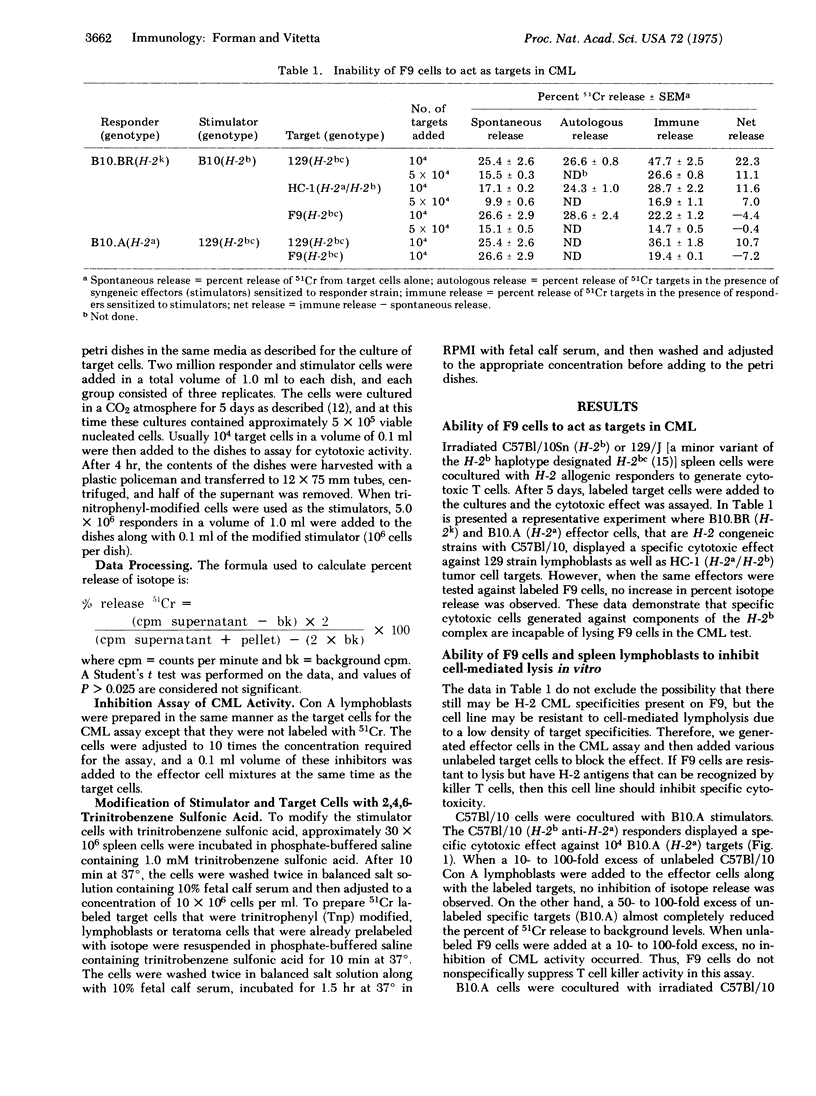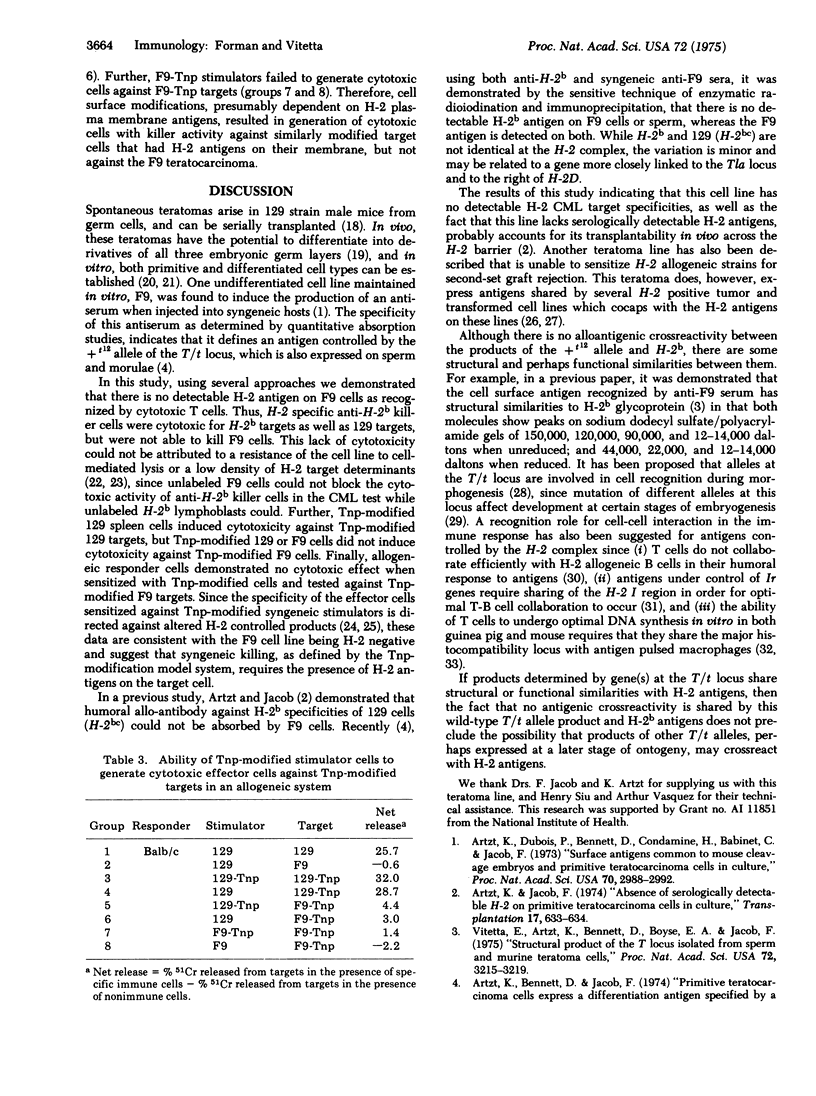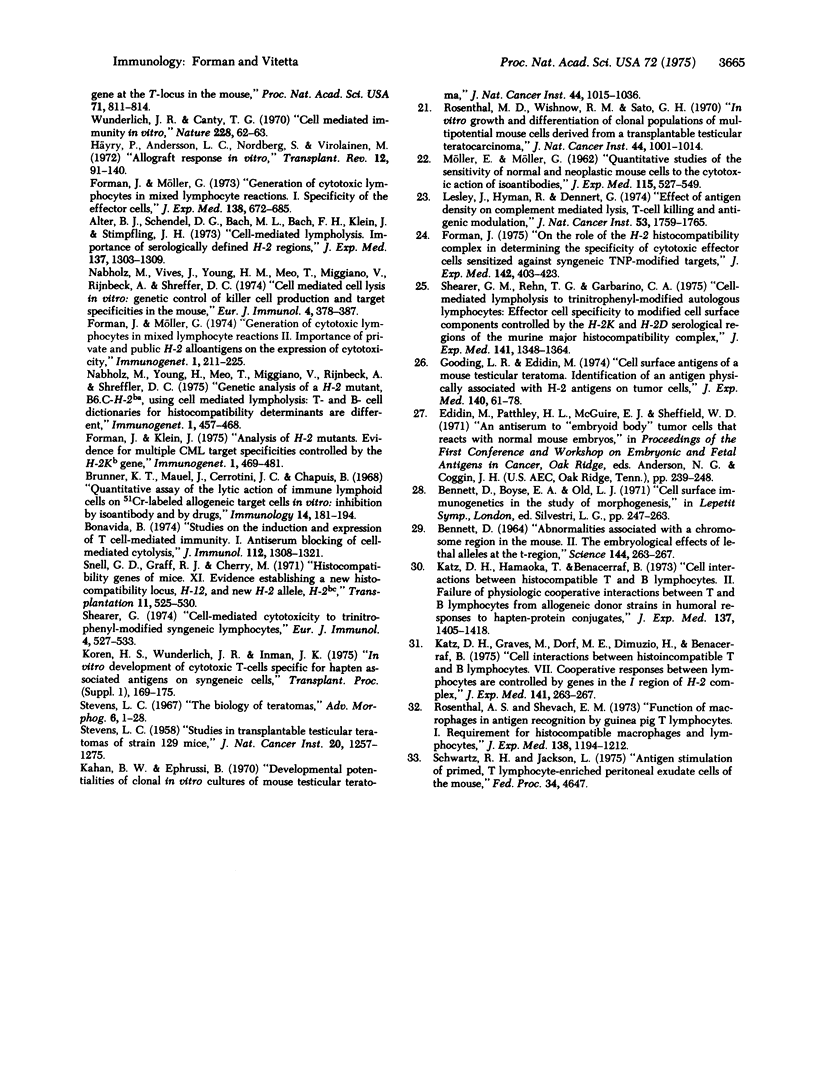Abstract
An established cell line of murine teratoma cells (F9), which lacks serologically detectable H-2 that is determined by a wild-type T/t locus gene. These cells are not killed and do not react with cytotoxic T cells sensitized to H-2 antigens in a cell-mediated lympholysis assay. Modification of spleen cells from the strain or origin (129) of this teratoma line with trinitrobenzene sulfonic acid allows the generation of syngeneic killer cells that display a cytotoxic effect against trinitrophenyl-modified splenic targets, but not against trinitrophenyl-modified F9 targets. Thus, the F9 antigen is structurally similar to H-2b but does not act as a target antigen in the cell-mediated lympholysis assay for anti-H-2b cytotoxic T cells, nor does it crossreact with H-2b antigens at the T cell level.
Full text
PDF




Selected References
These references are in PubMed. This may not be the complete list of references from this article.
- Alter B. J., Schendel D. J., Bach M. L., Bach F. H., Klein J., Stimpfling J. H. Cell-mediated lympholysis. Importance of serologically defined H-2 regions. J Exp Med. 1973 May 1;137(5):1303–1309. doi: 10.1084/jem.137.5.1303. [DOI] [PMC free article] [PubMed] [Google Scholar]
- Artzt K., Dubois P., Bennett D., Condamine H., Babinet C., Jacob F. Surface antigens common to mouse cleavage embryos and primitive teratocarcinoma cells in culture. Proc Natl Acad Sci U S A. 1973 Oct;70(10):2988–2992. doi: 10.1073/pnas.70.10.2988. [DOI] [PMC free article] [PubMed] [Google Scholar]
- Artzt K., Jacob F. Letter: Absence of serologically detectable H-2 on primitive teratocarcinoma cells in culture. Transplantation. 1974 Jun;17(6):632–634. doi: 10.1097/00007890-197406000-00015. [DOI] [PubMed] [Google Scholar]
- BENNETT D. ABNORMALITIES ASSOCIATED WITH A CHROMOSOME REGION IN THE MOUSE. II. EMBRYOLOGICAL EFFECTS OF LETHAL ALLELES IN THE T-REGION. Science. 1964 Apr 17;144(3616):263–267. [PubMed] [Google Scholar]
- Bonavida B. Studies on the induction and expression of T cell-mediated immunity. II. Antiserum blocking of cell-mediated cytolysis. J Immunol. 1974 Apr;112(4):1308–1321. [PubMed] [Google Scholar]
- Brunner K. T., Mauel J., Cerottini J. C., Chapuis B. Quantitative assay of the lytic action of immune lymphoid cells on 51-Cr-labelled allogeneic target cells in vitro; inhibition by isoantibody and by drugs. Immunology. 1968 Feb;14(2):181–196. [PMC free article] [PubMed] [Google Scholar]
- Forman J., Möller G. Generation of cytotoxic lymphocytes in mixed lymphocyte reactions. I. Specificity of the effector cells. J Exp Med. 1973 Sep 1;138(3):672–685. doi: 10.1084/jem.138.3.672. [DOI] [PMC free article] [PubMed] [Google Scholar]
- Forman J. On the role of the H-2 histocompatibility complex in determining the specificity of cytotoxic effector cells sensitized against syngeneic trinitrophenyl-modified targets. J Exp Med. 1975 Aug 1;142(2):403–418. doi: 10.1084/jem.142.2.403. [DOI] [PMC free article] [PubMed] [Google Scholar]
- Gooding L. R., Edidin M. Cell surface antigens of a mouse testicular teratoma. Identification of an antigen physically associated with H-2 antigens on tumor cells. J Exp Med. 1974 Jul 1;140(1):61–78. doi: 10.1084/jem.140.1.61. [DOI] [PMC free article] [PubMed] [Google Scholar]
- Häyry P., Andersson L. C., Nordling S., Virolainen M. Allograft response in vitro. Transplant Rev. 1972;12:91–140. doi: 10.1111/j.1600-065x.1972.tb00054.x. [DOI] [PubMed] [Google Scholar]
- Kahan B. W., Ephrussi B. Developmental potentialities of clonal in vitro cultures of mouse testicular teratoma. J Natl Cancer Inst. 1970 May;44(5):1015–1036. [PubMed] [Google Scholar]
- Katz D. H., Graves M., Dorf M. E., Dimuzio H., Benacerraf B. Cell interactions between histoincompatible T and B lymphocytes. VII. Cooperative responses between lymphocytes are controlled by genes in the I region of the H-2 complex. J Exp Med. 1975 Jan 1;141(1):263–268. doi: 10.1084/jem.141.1.263. [DOI] [PMC free article] [PubMed] [Google Scholar]
- Lesley J., Hyman R., Dennert G. Effect of antigen density on complement-mediated lysis, T-cell-mediated killing, and antigenic modulation. J Natl Cancer Inst. 1974 Dec;53(6):1759–1765. [PubMed] [Google Scholar]
- MOLLER E., MOLLER G. Quantitative studies of the sensitivity of normal and neoplastic mouse cells to the cytotoxic action of isoantibodies. J Exp Med. 1962 Mar 1;115:527–553. doi: 10.1084/jem.115.3.527. [DOI] [PMC free article] [PubMed] [Google Scholar]
- Nabholz M., Vives J., Young H. M., Meo T., Miggiano V., Rijnbeek A., Shreffler D. C. Cell-mediated cell lysis in vitro: genetic control of killer cell production and target specificities in the mouse. Eur J Immunol. 1974 May;4(5):378–387. doi: 10.1002/eji.1830040514. [DOI] [PubMed] [Google Scholar]
- Rosenthal A. S., Shevach E. M. Function of macrophages in antigen recognition by guinea pig T lymphocytes. I. Requirement for histocompatible macrophages and lymphocytes. J Exp Med. 1973 Nov 1;138(5):1194–1212. doi: 10.1084/jem.138.5.1194. [DOI] [PMC free article] [PubMed] [Google Scholar]
- Rosenthal M. D., Wishnow R. M., Sato G. H. In vitro growth and differetiation of clonal populations of multipotential mouse clls derived from a transplantable testicular teratocarcinoma. J Natl Cancer Inst. 1970 May;44(5):1001–1014. [PubMed] [Google Scholar]
- STEVENS L. C. Studies on transplantable testicular teratomas of strain 129 mice. J Natl Cancer Inst. 1958 Jun;20(6):1257–1275. doi: 10.1093/jnci/20.6.1257. [DOI] [PubMed] [Google Scholar]
- Shearer G. M. Cell-mediated cytotoxicity to trinitrophenyl-modified syngeneic lymphocytes. Eur J Immunol. 1974 Aug;4(8):527–533. doi: 10.1002/eji.1830040802. [DOI] [PubMed] [Google Scholar]
- Shearer G. M., Rehn T. G., Garbarino C. A. Cell-mediated lympholysis of trinitrophenyl-modified autologous lymphocytes. Effector cell specificity to modified cell surface components controlled by H-2K and H-2D serological regions of the murine major histocompatibility complex. J Exp Med. 1975 Jun 1;141(6):1348–1364. doi: 10.1084/jem.141.6.1348. [DOI] [PMC free article] [PubMed] [Google Scholar]
- Snell G. D., Graff R. J., Cherry M. Histocompatibility genes of mice. XI. Evidence establishing a new histocompatibility locus, H-12, and new H-2 allele, H-2bc. Transplantation. 1971 Jun;11(6):525–530. [PubMed] [Google Scholar]
- Vitetta E. S., Artzt K., Bennett D., Boyse E. A., Jacob F. Structural similarities between a product of the T/t-locus isolated from sperm and teratoma cells, and H-2 antigens isolated from splenocytes. Proc Natl Acad Sci U S A. 1975 Aug;72(8):3215–3219. doi: 10.1073/pnas.72.8.3215. [DOI] [PMC free article] [PubMed] [Google Scholar]
- Wunderlich J. R., Canty T. G. Cell mediated immunity induced in vitro. Nature. 1970 Oct 3;228(5266):62–63. doi: 10.1038/228062a0. [DOI] [PubMed] [Google Scholar]


